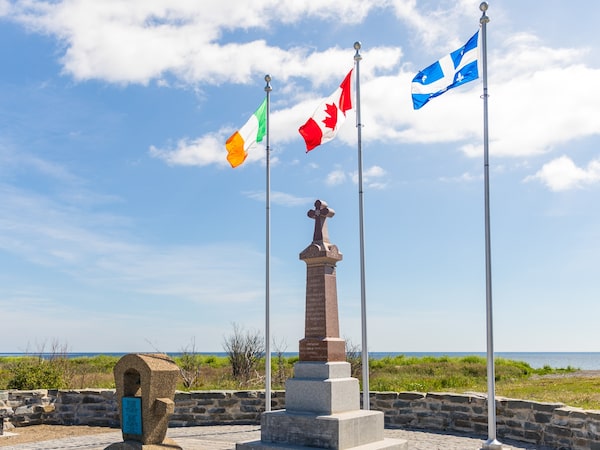
The Irish Memorial on Cap-des-Rosiers Beach, Quebec. The remains of Irish immigrants fleeing the potato famine that washed up on the beach in 2011 were buried near this monument.Parks Canada/Handout
Friday is St. Patrick’s Day, and March is Irish Heritage Month, making this a good time to pay tribute to one of Canada’s founding peoples.
We are reconsidering our history. The settler culture that forged this country is the same culture that displaced First Nations, Métis and Inuit. Statues are being toppled and books rewritten.
The Irish both dispossessed and were themselves dispossessed. Many fled an oppressed and impoverished land, or were forced to flee by landlords or English occupiers.
“They weren’t immigrants,” said Eamonn McKee, Ireland’s ambassador to Canada. “They were refugees.” And in fleeing, they occupied the lands of those who were already here.
Mr. McKee is spearheading a project called Fifty Irish Lives in Canada, which seeks to chronicle the contribution of the Irish to Canada’s development through a series of brief biographies.
The first profile is devoted to Tadhg O’Brennan, the first documented Irish-born immigrant to Canada. He arrived in 1661 at the age of 29, following Cromwell’s invasion of Ireland. Waves of Irish Catholics fled the English Protestant domination of their homeland, many of them travelling to France and then New France.
Many of the Irish of Quebec who came later arrived as children orphaned on the voyage of the “coffin ships,” as they were called, in which a fifth of the passengers typically died during the journey or in quarantine after it. Adopted by local families, they became integral to francophone Canada.
In contrast, most of those in the first wave of Irish settlement in Ontario in the early 1800s were Protestant, with large numbers of Catholics arriving during the Irish Famine, which began in 1845.
One of the biographies is devoted to Ellen Dease, who came to Toronto in 1847 to teach but found herself ministering to refugees from the Irish famine who were suffering from tuberculosis and other diseases. Many of her compatriots died from the diseases of their patients, but Mother Teresa Dease, as she became, oversaw the expansion of schools and convents in Canada and the United States as founder of the Loretto Sisters in North America.
The Irish were among the first Europeans to set foot on what would become Canadian land. Fishers dried cod on the shores of Newfoundland in the mid-1600s, eventually settling there and in what would become the Maritime provinces.
Many of the people of Atlantic Canada still speak with accents influenced by Irish and Scottish ancestors, and a similar accent can also be detected, more faintly, among some inhabitants of the Ottawa Valley. At Confederation in 1867 the Irish comprised a quarter of Canada’s population. Today about 13 per cent of Canadians are of Irish heritage.
The Irish helped bind the country together in the mid-1800s. They spoke English, like the British Protestant settlers of Upper Canada, but many were Catholic, like the French in Quebec.
Though they warred among themselves and against others - the Protestant/Catholic divide was a leading source of social tension in Canada until the 1960s - they thrived in every field: in politics—Thomas Darcy McGee was a father of Confederation—and business—from the brewer Eugene O’Keefe to the department store founder Timothy Eaton— and sports—the names Clancy and Keon and McDavid and many others of Irish origin are legendary in the NHL—and the arts, from Alice Munro to Stompin’ Tom Connors. Many of Canada’s prime ministers, from John Thompson to Brian Mulroney to Justin Trudeau, had or have Irish blood in their veins.
“The prominent Irish could only achieve their pre-eminence from within the communities of ordinary Irish whose own lives as immigrants were extraordinary in themselves,” wrote Mark McGowan, professor of history and Celtic Studies at University of Toronto, in his introduction to the project. “Without those generations, neither the Canada of today nor the Irish community of Canada would have been possible.”
As we seek to reconcile the injustices and accomplishments of our past, we would do well to remember the contribution of the Irish to Canada. Many of them came here with nothing: weakened, orphaned, shunned, dispossessed.
They helped to shape the society we live in today. It is impossible to imagine this country without them.
Everyone is Irish on March 17. So a Happy St. Patrick’s Day to us all.
 John Ibbitson
John Ibbitson